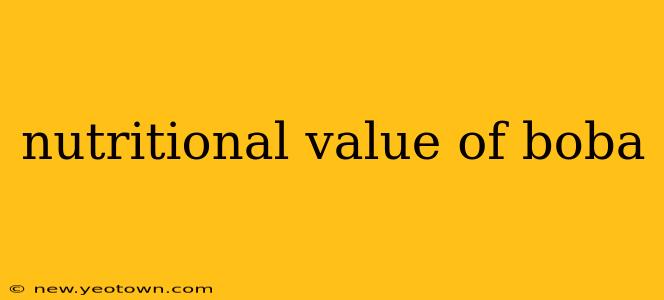Boba tea, with its chewy tapioca pearls and a wide array of flavor combinations, has taken the world by storm. But beyond the delightful experience, lies a question many curious consumers ask: what's the nutritional value of boba? The truth, like the perfect boba blend, is complex and multifaceted. It depends heavily on the specific ingredients used – the type of tea, the added milk or cream, the sweetness level, and of course, those beloved tapioca pearls.
Let's embark on a journey to unravel the nutritional profile of this popular drink, addressing some frequently asked questions along the way.
What are the main ingredients in boba tea, and how do they contribute to its nutritional value?
The foundation of boba tea is typically tea – black tea, green tea, or oolong tea – each offering its own unique antioxidant profile. These antioxidants are beneficial for health, contributing to fighting free radicals and potentially reducing the risk of chronic diseases. However, the nutritional benefits can be significantly altered depending on the additions. Many boba drinks include milk or cream, significantly increasing the calorie and fat content. The sweetness, often derived from sugar or syrups, further elevates the calorie count and sugar content, potentially impacting blood sugar levels. Finally, the tapioca pearls themselves add calories and carbohydrates, contributing to the overall nutritional profile.
How many calories are in a typical cup of boba?
This is a tricky question with no single answer. A small, unsweetened black tea boba with minimal tapioca pearls might hover around 150-200 calories. However, a large, milk tea boba with added sugar and a generous portion of tapioca pearls could easily exceed 500-700 calories, sometimes even more. The calorie count dramatically increases with the addition of cream, flavored syrups, and extra pearls.
Is boba tea healthy? What are the potential health benefits and drawbacks?
The "healthy" label for boba tea is definitely debatable. On one hand, the tea base can provide antioxidants, which offer potential health benefits. However, the high sugar content, added fats from milk or cream, and the substantial calorie count from the tapioca pearls outweigh these advantages for most variations. Excessive consumption of boba tea can contribute to weight gain, increased risk of type 2 diabetes, and other health problems associated with high sugar and calorie intake. Moderation is key.
What are some healthier alternatives or modifications to make boba tea less unhealthy?
Fortunately, you can enjoy boba tea more responsibly. Opt for unsweetened tea bases, choose low-fat or non-dairy milk alternatives (like almond or soy milk), and ask for less sugar or a sugar-free syrup. Reducing the amount of tapioca pearls can also significantly lower the calorie and carbohydrate content. Consider exploring fruit-infused variations that minimize added sugars, relying on the natural sweetness of fruits instead.
Does boba tea contain any vitamins or minerals?
The nutritional content beyond the antioxidants in tea itself is generally minimal. The tapioca pearls offer some carbohydrates, and depending on the milk used, you might receive small amounts of calcium and other nutrients. However, these contributions are often overshadowed by the less desirable nutritional aspects of many boba tea varieties.
Are there any allergies associated with boba tea?
Yes, potential allergens include milk (for those with lactose intolerance or milk allergies), nuts (if nut-based milk alternatives or syrups are used), and soy (if soy milk is used). Always be sure to check the ingredients list and inform the staff of any allergies before ordering.
Conclusion: Savoring Boba Responsibly
Boba tea can be a delicious treat, but mindful consumption is crucial. By understanding the nutritional aspects and making healthier choices, you can enjoy this popular beverage without compromising your well-being. Remember, moderation is key to appreciating this sweet treat responsibly and as part of a balanced diet.

